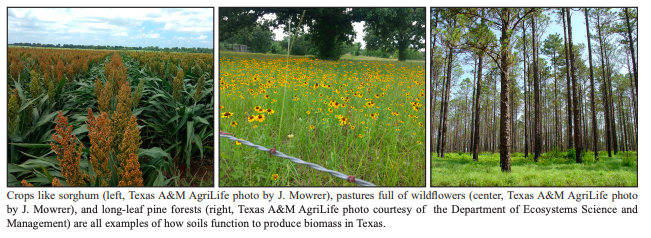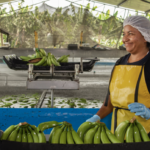Seven key soil functions

The content of this article 'Seven key soil functions' was by Texas A&M AgriLife Extension and has been revised and republished by FreshFruitPortal.com.
Soils can be thought of as providing 7 key functions in the environment. All of these key functions are at play in the State of Texas every day.
Recognition that it is not a limitless resource and that its appreciation and protection can improve the impact of these functions. Each function plays a role in the provision of ecosystem services that provides benefits to all Texans.
Food production (agriculture and forestry)
The soil functions as a medium to support the plants that we use to produce food, fiber, and bio-energy materials.
It serves as a physical support and protective environment for plant roots. It provides a reservoir of available water and nutrients for plant growth.
Plant growth is a direct result of photosynthetic activity (absorbing sunlight) to produce plant material and energy.
Plant material decays in the soil due to the activity of microorganisms, which use it for their energy and growth.
- There are approximately 550 billion tons of plant animal, and microbial biomass on Earth
- Plants, including crops and forests, make up 450 billion tons, or 82% of the total biomass on Earth
Transforming nutrients, filtering and storing water
The soil is a vast reserve for water storage across the world.
The texture of a soil (i.e., the content of sand, silt, and clay particles), as well as the density with which it is compacted, affects the rate at which water moves through the soil.
Sandy soils generally allow water to move more rapidly, while ones containing greater amounts of clay can store more water for plants.
Microorganisms living in the spaces between soil particles use water and nutrients just as plants do.
These bacteria, fungi, and very small insects also feed on decaying plant material to release nutrients in the soil.
The movement of water and the transformation of nutrients and organic residues serve as a vast filtering and detoxification system for precipitation (e.g., rain and snow) around the world.
Although less than 1% of the world’s supply is stored at any given time in rivers, lakes, and soil, the passage of water through these systems provides an invaluable service in improving its quality for drinking and irrigation.
Soil can treat sewage to reduce human exposure to disease-causing organisms. In fact, this is exactly what a household septic system does!
Reservoir for genetic biodiversity and for species habitat
Soil provides a habitat for the greatest diversity of microorganism species than any other environment on the planet, and can be considered its own micro-ecosystem.
In fact, there are more individual microorganisms in a spoonful of soil than there are people on this earth.
Soil microorganisms occupy many important niches within their environment, providing many different services such as plant residue decomposition, providing nutrients for plants, and degradation of pollutants.
Many commonly used antibiotics for human medical treatments are in fact produced by soil microorganism, while many more are yet to be undiscovered, but represent an exciting frontier for the future of human and animal health.
Larger organisms, including many insects, mammals, and reptiles make their home in the soil as well.
- Every gram (~ 0.035 oz) contains approximately 1 billion bacterial cells.
- Children’s immune systems are made more robust by early exposure to soil organisms.
- The management of land has a very big influence on soil biodiversity.
Physical environment for humanity and its culture
In areas where the soil or climate hinders adequate food production or water availability, resources such as food and water must be transported in from far away.
They provide a foundational support for all buildings we live and work in as well as support the parks and natural areas we recreate in as well.
It is a landscaping and engineering medium to be dealt with when planning and building transportation systems such as highways and railroads.
Soils are also used as a medium for the concealment and disposal of vast amounts of refuse. In Texas, we deal with special ones that shrink when dry and swell when wet.
The cracking and heaving caused by this behavior demands special consideration when building structures on these soils.
Source of raw materials for industries and buildings
Soils provide many raw material deposits. Sands may be collected for building.
Clays may be used for ceramics. Some clay minerals are also used in variety of industrial products. One example is bentonite clay used as drilling fluid by oil industry.
Texas also mines a large amount of raw materials for limestone and cement.
Carbon storage
Carbon is the basis for all life on Earth. It exists in many forms, including the carbon dioxide (CO2) that makes up a small portion of our atmosphere (~ 0.041%).
In soils, carbon may be part of the inorganic mineral complex. It may also be part of living organisms or of decaying organic tissue.
This form of carbon is called soil organic carbon (SOC).
There is more carbon in and under the Earth’s soil than is contained in all the plants that grow above its surface.
There remains a high potential for increased carbon storage in soils that can have a positive effect on both biomass production and the regulation of atmospheric CO2 balances.
Texas has 12 separate eco regions and 1300 soil types, combining to create a multitude of different capacities for storing carbon across the state.
Geologic and archeological heritage archive
When we gaze across the surface of the landscape, we may forget that the soil has a history that is often linked with the history of human activity.
Soils often conceal and protect paleontological and archeological treasures of considerable value towards better understanding the history of our planet and ourselves.
They may also be considered a reservoir for much more recently placed information for use in forensic investigations of crime scenes.
By Jake Mowrer, Ph.D. - Texas A&M AgriLife Extension Specialist for Soil Nutrient & Water Resource Management; Julie Howe, Ph.D. - Texas A&M AgriLife Research Soil Chemist; Tony Provin, Ph.D. - Texas A&M AgriLife Extension Soil Chemist of the Department of Soil and Crop Sciences.

















































